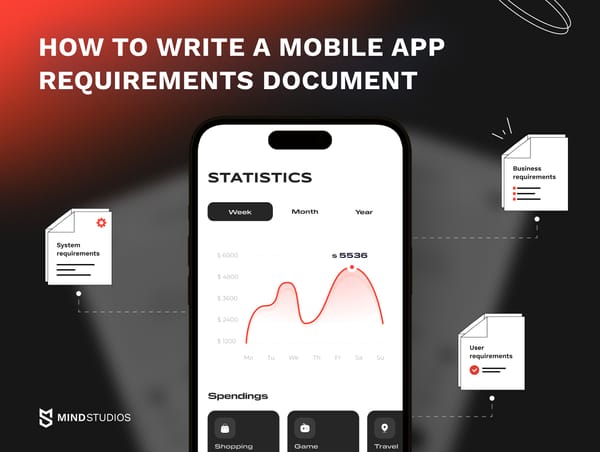According to The Good Body, more than 300 million people worldwide practice yoga. By 2022, the global market for yoga is said to have reached USD 88 billion, its CAGR exceeding the predictions made in 2021. Today, the yoga market’s CAGR is 11.7% (it was predicted to be around 9.6% before).
If you’re thinking about jumping on this bandwagon, Mind Studios can help you validate your idea about online yoga app development and build a working MVP — as a company whose portfolio features several yoga and mindfulness apps.
We’ll be including some insights from our partial involvement in working on one of the leaders in the yoga app market: Asana Rebel.
Without further ado, let’s talk! The most important components of a successful yoga app development on a real life example we experienced with Asana Rebel and competitors we analyzed during the app development stage.
Finding the target audience for yoga app
While the number of yoga practitioners grows every year, the target audience of a yoga fitness app depends on the type of yoga that it teaches. We can distinguish the following types of yoga, and as a result, the following target audiences:
- Ashtanga Vinyasa. This yoga is especially popular with teenagers because of its similarity to aerobic workouts. There are only nine vinyasas (dynamic asanas using a special breathing technique) that flow one after another without stopping, with repetitions.
- Iyengar. The purpose of these classes is to heal after injuries with the help of certain asanas (the creator of this type of yoga had poor health as a child). The inventor of this method of yoga came up with exercises to help those for whom even simple asanas may seem difficult: pregnant women, elderly and sick people, and children.
- Jivamukti. This is yoga through the eyes of Americans. At the heart of the author’s style is Hatha, with new vinyasas that look like a dance. There’s also a divine component, reading sacred texts, singing mantras, meditation, and vegetarianism.
Each segment of the target audience can solve its particular problems through yoga. This may be overcoming bad habits, making lifestyle changes, improving health and getting back up after injuries, or preparing the body for changes. Yoga can help solve these problems as efficiently as possible.
Profile of an average yoga practitioner
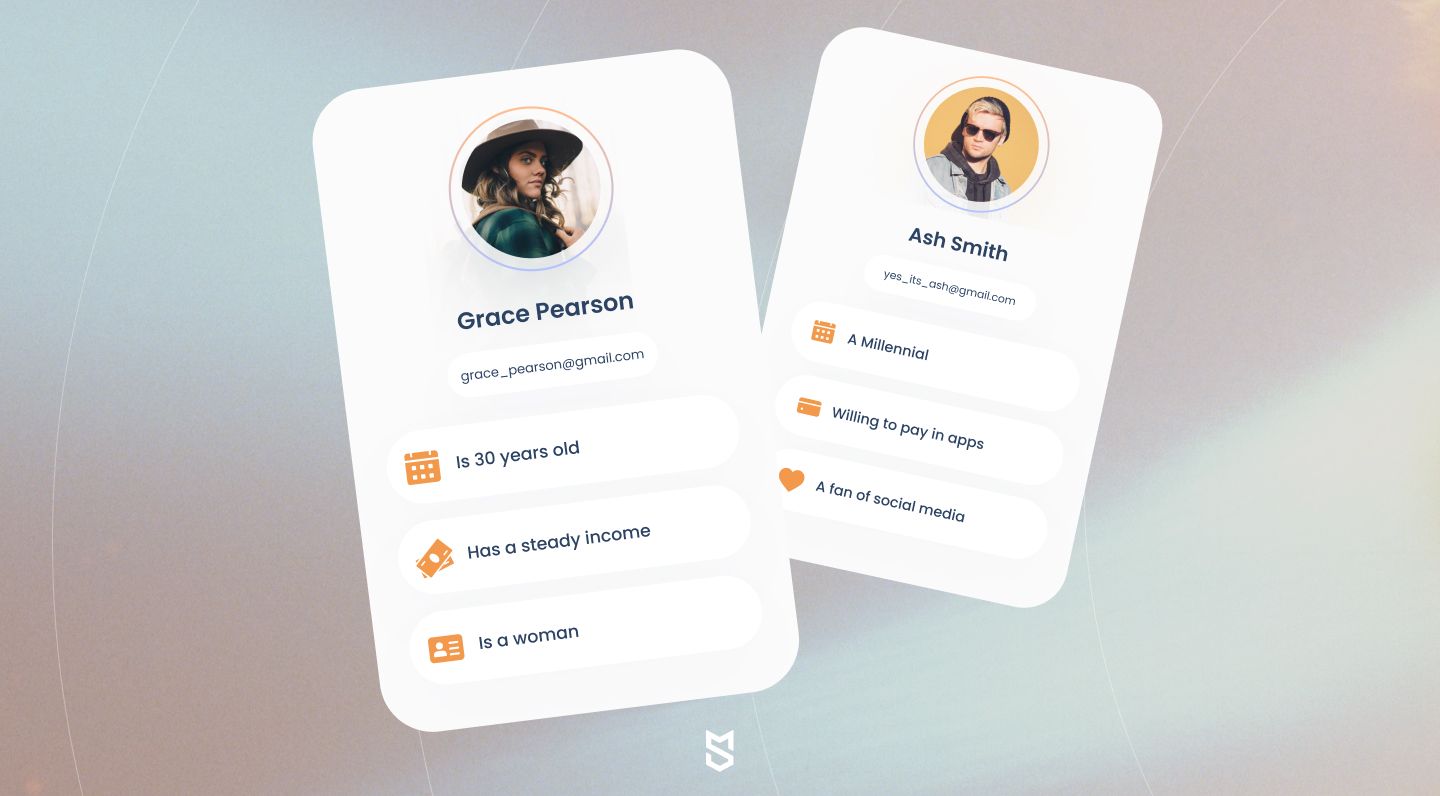
Here’s a portrait of the average yoga student. According to the study by Breathe, the average yoga student:
- Is 30 years old
- Has a steady income
- Is a woman
This portrait is somewhat similar to the portrait of the average mobile application user:
- A Millennial (approximately 30 years old)
- Willing to pay in apps
- A fan of social media
Financial circumstances of the target audience
Yoga classes in studios cost $10 to $30 per class or $100 to $200 per month. And this is only the cost of the lessons themselves. Add here the cost of the yoga mat, clothing, and training materials. Dedicated yoga practitioners spend a pretty penny to maintain the practice.
And because yoga is a popular practice these days, the idea to build a mobile app for yoga has high potential to be lucrative.
Yoga app monetization on the example Asana Rebel
Asana Rebel is free to download and is monetized by selling subscriptions, which makes it a freemium app. Freemium is the most popular monetization model in apps that promote wellbeing — yoga, fitness, meditation apps, etc.
Yoga solutions like these offer a limited number of exercises for free, so that anyone could use the app and benefit from it to some extent. Even a small amount of exercise can be beneficial to one’s health, after all. But to get the best results, users need to access the full scope of functionality, which is paid.
By the way, Asana Rebel is an app with one of the most versatile subscription offers: you can pay monthly, per 3 months, or yearly, and there are also several “tiers” — Asana Rebel Pro, Life, Super, and Rebel Premium.
Asana Rebel has a price tag in the regional currency for each region it’s available in. The list in US dollars looks like this:
| Rebel Premium (yearly) | $58.99 |
| Asana Rebel Super | $35.99 |
| Rebel Pro 3 Months | $37.99 |
| Unlock Everything 12 Months | $58.99 |
| Rebel Pro (monthly) | $15.99 | Asana Rebel Pro (monthly) | $15.99 |
| Premium 12 Months | $69.99 |
| Asana Rebel Pro (yearly) | $82.99 |
| Asana Rebel Life (6 months) | $69.99 |
| Asana Rebel Pro (6 months) | $69.99 |
What other monetization options do you have when you build your own yoga routine app?
- If you’re an owner of a studio with existing clientele and want to expand into digital space and offer remote training, a paid download might work for your business.
- Ads are the monetization model for apps that are totally free and sometimes as a part of freemium models where you don’t want to limit the content access (users can subscribe to get rid of ads).
- You can offer in-app purchases for meal plans, specific sets of exercises, or personal guidance by a coach.
How to make an app like Asana Rebel: Features to implement
Applications for yoga can be divided into two types: applications that let users practice independently and applications that connect users with yoga instructors (apps for yoga teachers). Here are the features that you should implement when you create a yoga app of each type.
Of course, the cost to make an Asana Rebel-like app will depend on the set of features that you implement. So if you want to build your own yoga routine app, check the following features.
Features for a yoga practitioners’ app
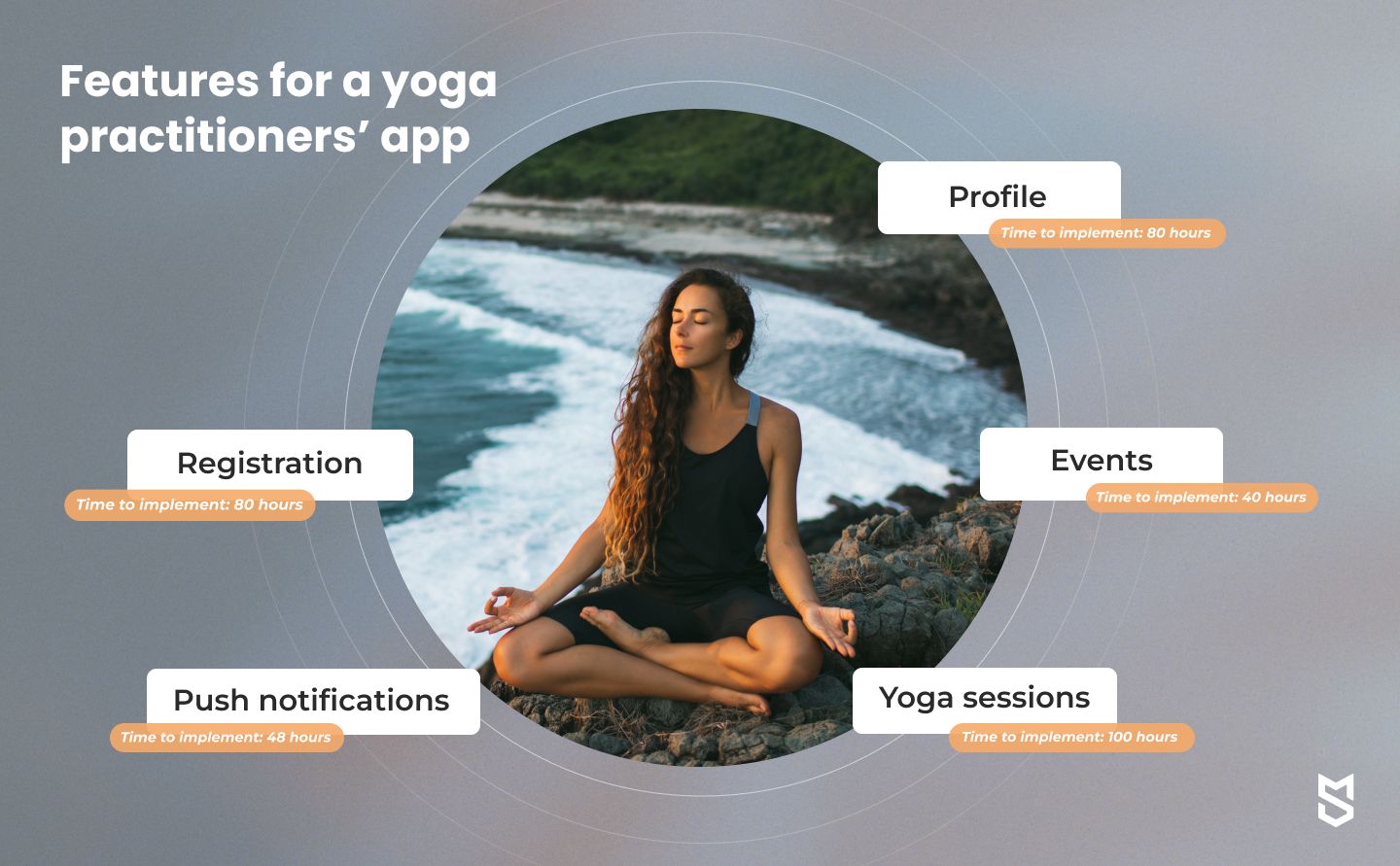
Registration and onboarding
This is a standard feature of any application that provides quick access to the program by entering an email address or phone number or by using social networks, asks users about their goals, and more.
Time to implement: 80+ hours
Yoga sessions
This panel allows users to manage lessons, see progress, re-enter completed lessons, and schedule sessions on a calendar.
Time to implement: 100 hours
Events
Practitioners can see planned yoga activities and sign up for or cancel classes.
Time to implement: 40 hours
Push notifications
Users may want to receive notifications, for example, every time new material appears on the blog. Notifications must be customizable.
Time to implement: 48 hours
Profile
Users can manage their personal data.
Time to implement: 80 hours
Features for a yoga teacher app
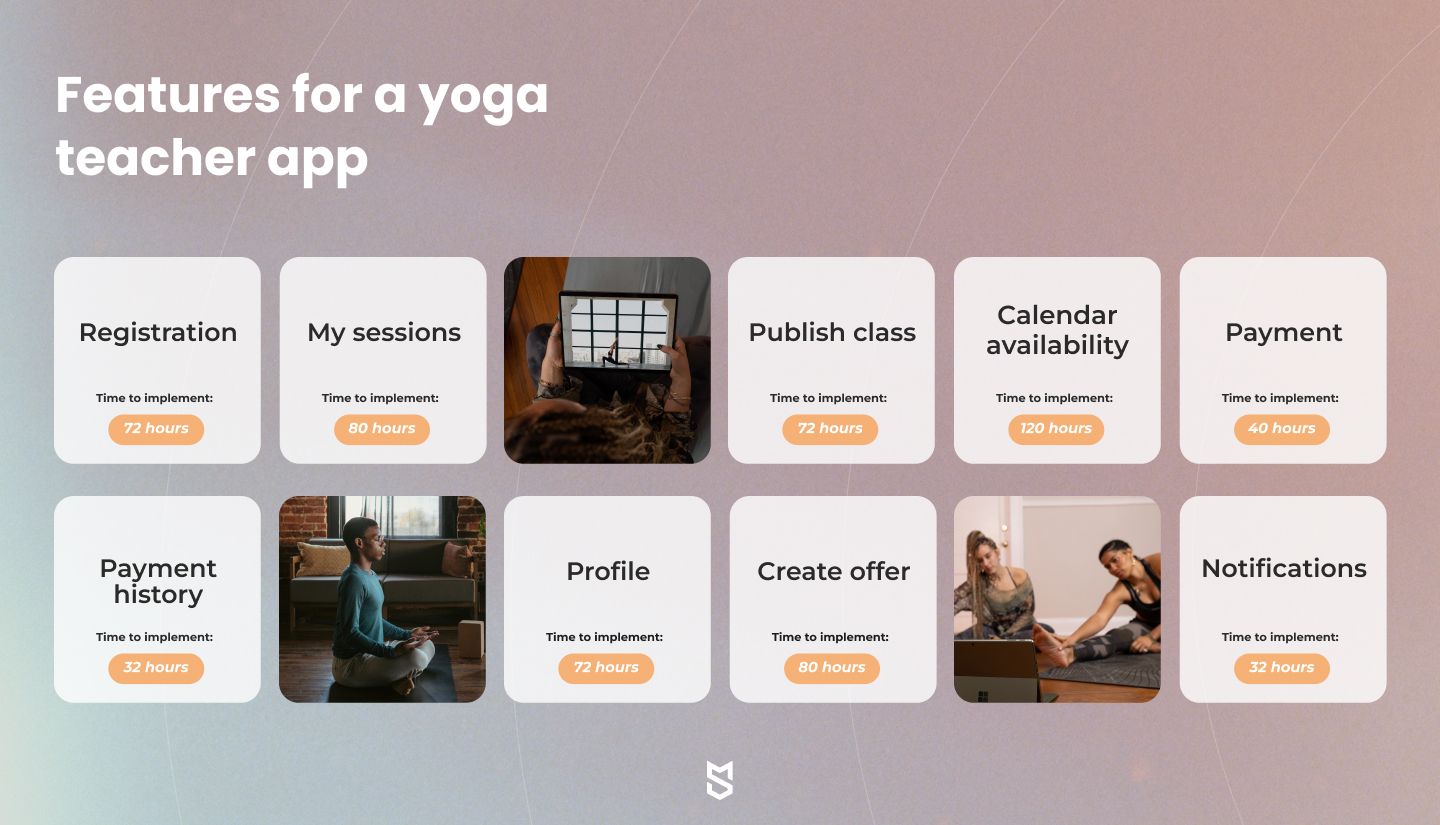
Registration & Login
This is the standard form required to submit data and quickly access the application for yoga.
Time to implement: 72 hours
My sessions
Allows users to see the number of lessons booked and manage them.
Time to implement: 80 hours
Create offer
This feature allows teachers to create their own training programs and offer them to students.
Time to implement: 120 hours
Publish class
Teachers can create their own training programs and share them with all their students in the app.
Time to implement: 72 hours
Calendar availability
This feature allows teachers to keep track of busyness and see scheduled and canceled lessons on the calendar.
Time to implement: 120 hours
Payment
Teachers can see paid and unpaid lessons.
Time to implement: 40 hours
Payment history
Teachers can see the history of all payments they’ve received.
Time to implement: 32 hours
Profile
This is a standard form allowing teachers to give all necessary information about themselves.
Time to implement: 78 hours
Push notifications
Teachers can receive notifications when their lessons are booked/ paid/canceled or when a user writes a question or comment or gives a rating.
Time to implement: 32 hours
Additional features for your yoga app
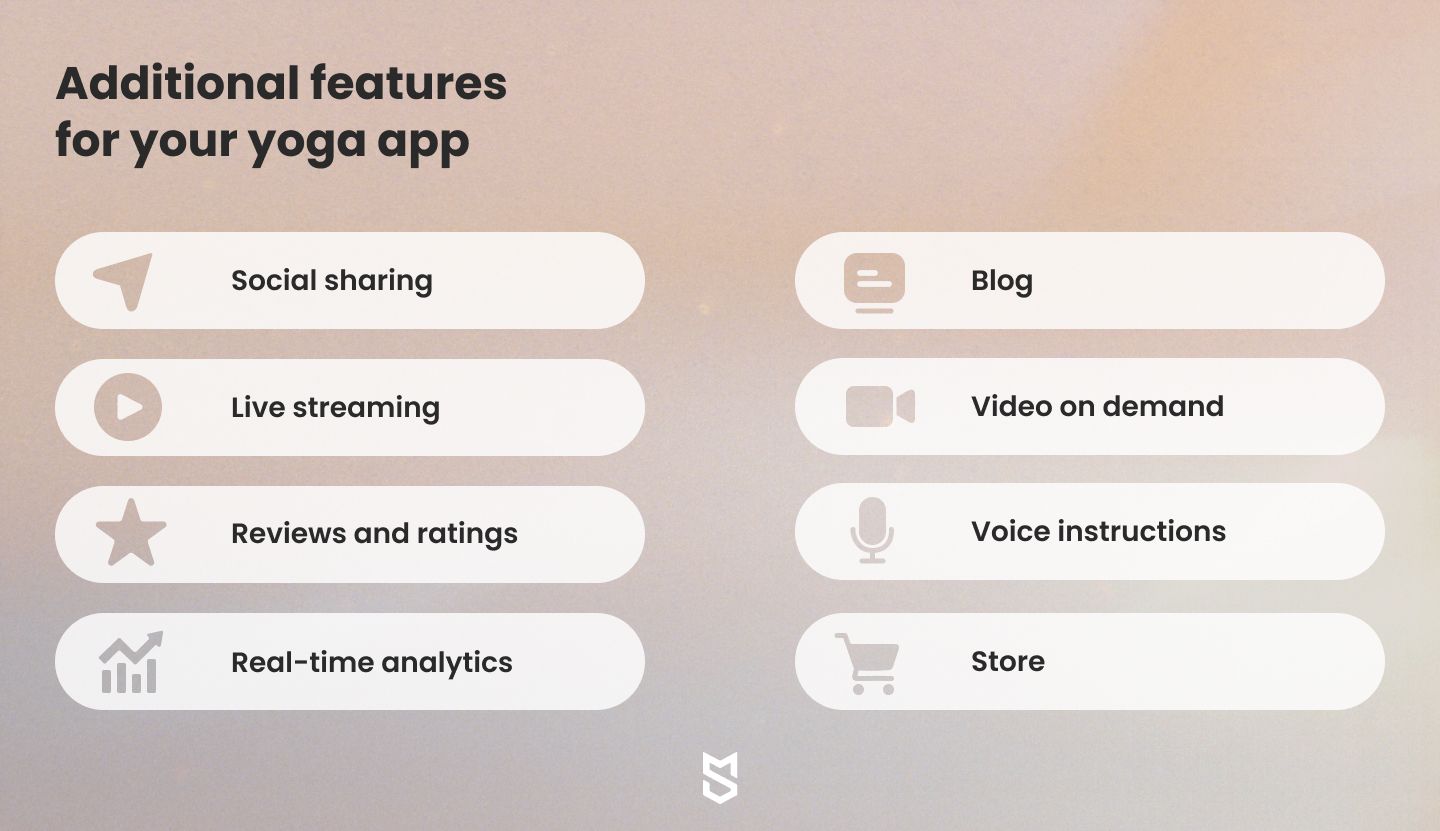
An app on the market as popular as yoga needs an edge in addition to the standard features we’ve listed above. Below we offer you some extra features you might want to consider. Keep in mind that these additional features will affect the duration and the cost of your online yoga app development.
- Social sharing. Today, sharing success has become part of success itself, so we highly recommend implementing this feature, although it’s not a necessary one for core app functionality.
- Video on demand. People perceive visual information better and process it faster than textual information. And while you can also choose to provide tutorials in photos, text, or animated drawings, embedded video tutorials can be a valuable addition for yoga fans.
- Live streaming. This feature will be equally useful for students and teachers. Live streaming allows teachers to conduct lessons in real time through the application.
- Reviews and ratings. This feature can be nicely implemented in a yoga application, allowing users to give marks or write reviews about teachers. The same system is perfectly applicable to video and audio materials, tutorials, and master classes placed in the application.
- Blog. If this tool is implemented correctly and contains really cool content, then it’s possible to increase involvement in the application several times over.
- Store. This functionality involves a connection to the online store and allows users to buy everything necessary for yoga. Particularly useful for studio owners who also sell yoga apparel and equipment. If you don’t sell anything yourself, you can also partner with certain stores for extra revenue.
- Real-time analytics. This feature is implemented on the admin panel side and allows the owner of the application to receive current information about its usage. You can take it a step further and offer analytics to your yoga teacher users.
- Voice instructions would be a nice extra accessibility-related feature.
Yoga app development tech stack
The tech stack for yoga and meditation app development can be varied depending on the features you want, your budget, and your in-house or outsourcing mobile app development team's skill set. Here, we’ll offer some basic technologies and you can ask our consultants for alternatives during a free consultation if you wish.
| Yoga app tech stack | |
|---|---|
| Android app | Kotlin |
| iOS app | Swift |
| Database | PostgreSQL, MySQL, MongoDB |
| Backend framework | Ruby on Rails, Elixir, Node.js |
| Front-end | Vue.js, Axios, Bootstrap, Webpack, Video.js, TipTap, Sass |
| Cloud storage | Amazon S3, Google Cloud Storage |
| Servers | Dedicated OVH servers, Amazon EC2 instances |
| CDN (for global apps) | Cloudflare, OVH CDN, Amazon CloudFront, Microsoft Azure |
| Streaming (for video and audio) | Apple HLS, MPEG-DASH, WebRTC, FFmpeg, AWS Lambda, m3u streams |
| Push notifications | Firebase, APNs, Twilio, Firebase Cloud Messaging |
| Payment gateway | PayPal, Authorize.net, Stripe |
UI/UX design for your yoga app
Design is an important part when you build your own practice yoga app. Since yoga is a wellness practice, an app offering yoga lessons needs to be intuitive and straightforward, to not cause users extra stress on top of everything they’re already dealing with.
What do our designers advise when it comes to yoga apps?
- Clean interface. Minimum clutter, ample white space, easily readable fonts.
- Colors that aren’t stressing for the eyes. Too bright colors might be distracting, so we usually suggest muted colors, like in our Envol healing tool. Though of course, if your branding uses bright colors it’s best to use them; in this case, we’ll work on achieving balance.
- Straightforward menus. Yoga apps require easy to navigate menus since practice sessions are aimed at balancing body and mind alike. Too intricate paths between sections might frustrate users to no end.
Challenges developing a yoga meditation app
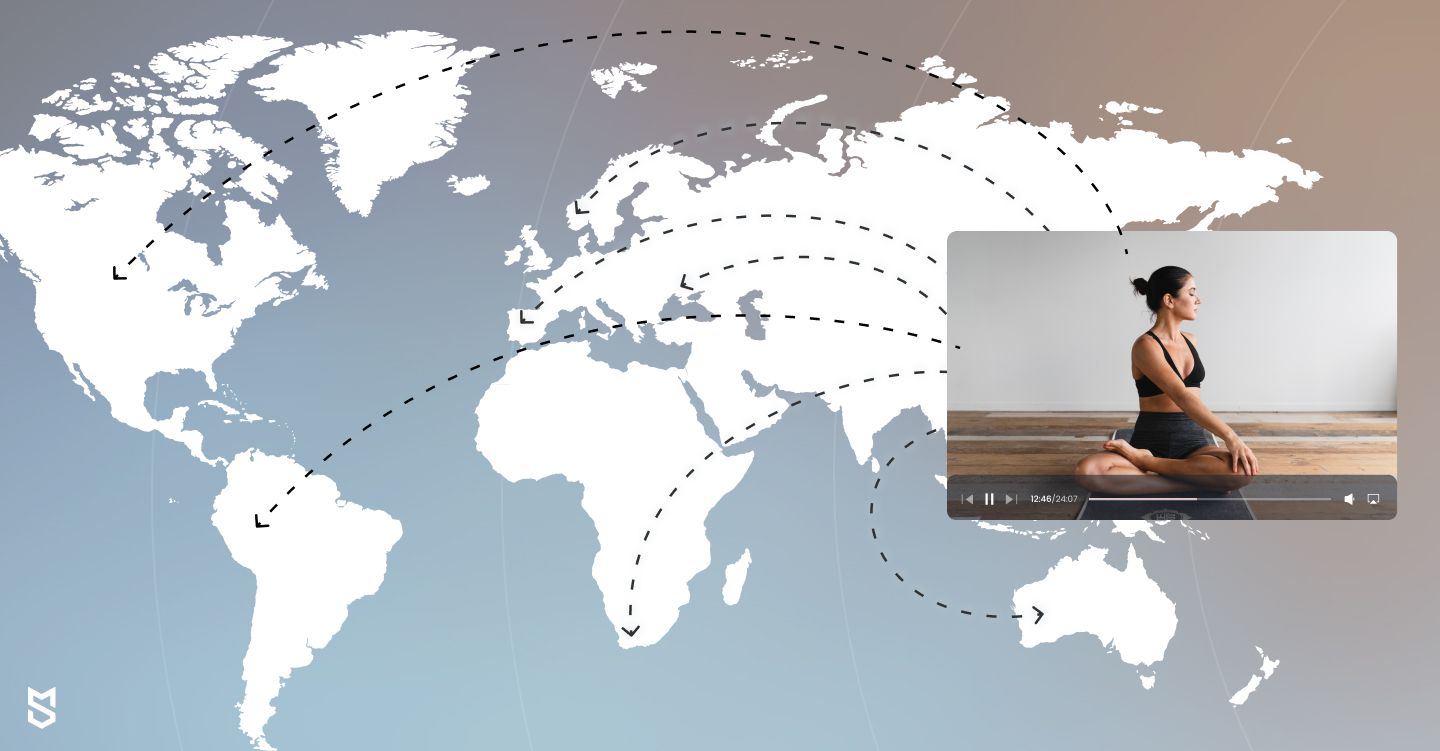
Certain parts of a yoga fitness app are more important than others, and some of the core functionality is tricky to implement. Here are just three possible roadblocks your developers might encounter, based on our experience developing multiple yoga apps.
Streaming
If you decide to create your own yoga sequence app with audio and video content, you’ll need strong streaming technology. One of the reasons people drop fitness apps is the quality of playback under different circumstances.
Long video files recorded at top quality might take a lot of time to load if the user’s internet connection is unstable or slow. Streaming protocols provide simultaneous loading and playback so that users don’t need to wait for the whole video to load, but there’s another thing you need to consider.
For the best user experience, your app will need a streaming technology capable of creating several options for loaded video, all of different quality. This way, if the user has a slow connection they will be able to choose a lower-quality video for playback and still get their yoga session completed without a glitch.
CDN
For an app that works on a large territory, you’ll need to use a content delivery network — a service that will create copies of your app’s content stored at servers in several locations. This is necessary for faster and smoother delivery to users’ devices. Multiple options exist for CDN, you’ll need to consider your target locations to choose the service with the most suitable servers.
Localization
The world is rapidly becoming more globalized, and these days, the population of almost any country might speak several languages. English is considered the international language but it doesn’t mean people will use it everywhere and for all their activities.
The least you can do is offer your app’s interface in a selection of languages depending on the area you’re launching in. For example, in the US, 38.3 million people consider Spanish their first and primary language. Canada has two official languages — English and French. Switzerland has four: German, French, Italian, and Romansh.
To attract more users, it’s important to consider demographics and language preferences in all areas your app will cover.
How much does it cost to build a yoga sequence app
As you can see, developing a mobile app for yoga is rather complicated. The cost to make a yoga mobile app will depend on the target audience, the complexity of the design, the necessary functionality, and the platform you choose to build for.
Here’s the approximate amount of time and investment required to implement all the necessary parts of a yoga app.
| Stage | Time, hrs | Cost, USD |
|---|---|---|
| Android app | 990+ | $44,550 |
| iOS app | 960+ | $43,200 |
| Front-end (website) | 680 | $30,600 |
| Backend | 878+ | $39,510 |
| UI/UX design | 200+ | $9,000 |
| Testing + project management | 640 | $28,800 |
| TOTAL | 4,348 | $195,660 |
As a rough guide, we can approximately estimate a yoga app to cost $195,660 and up. At Mind Studios, we do everything possible to save your resources without sacrificing the quality of the app.
Mind Studios Experience
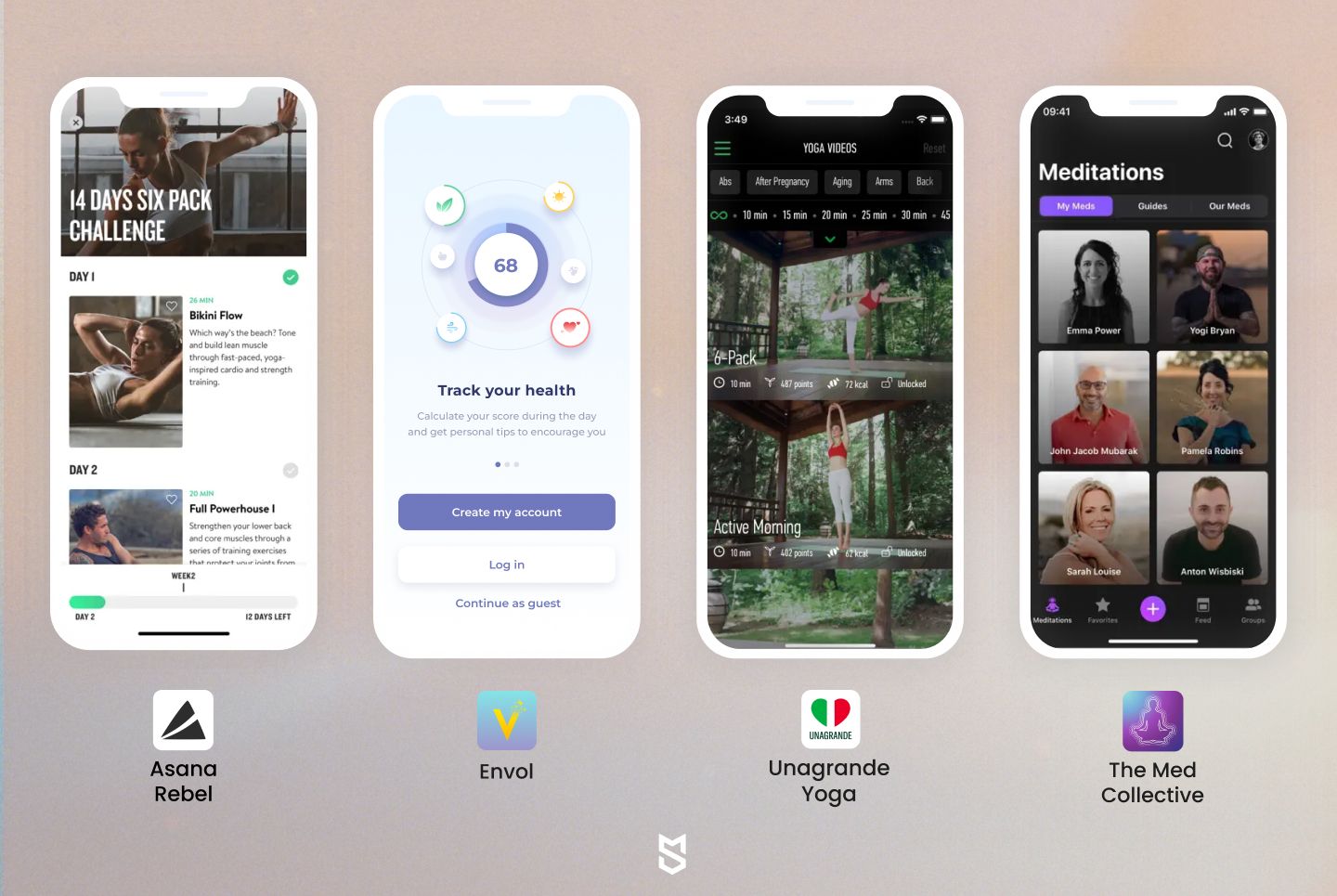
Our company considers yoga and meditation apps as one of our key industries, experience-wise. We’ve built several apps in the yoga and mindfulness category, and we’ve even been part of Asana Rebel development. What else do we have to offer from our portfolio?
Asana Rebel
The Asana Rebel project came to us for updates and maintenance of their Android app. Being a legacy app — an app we did not develop from scratch but had to reverse engineer to work with — Asana Rebel was a challenge of sorts. But we’re not the ones to back out of challenges 😎
Throughout the year 2022, the Mind Studios team was in charge of implementing new features into the existing app architecture. Here are just a few examples of what features had us behind them:
- Beginner introduction flow, a feature that will help build a routine from the get-go even for users taking their first steps at yoga.
- Up-to-date and tagged Nutrition feature where recipes are properly labeled for vegetarians, vegans, people who stick to the gluten-free diet, and more.
- Meditation and workouts audio are now downloadable for offline use.
- Weekly goals and 7 / 14 / 21-day Challenges for workout/yoga sessions, with reminders and activity tracking.
- Daily quiz with simple questions and answers explained, for example, about nutritional value and health benefits of certain products.
- Advice on workouts based on daily mood: Whether users would like to feel energized, strong, relaxed, etc., the algorithm we built will suggest a proper exercise session.
- Daily water intake and weight tracker similar to Google Fit
Unagrande Yoga
An iOS yoga app with a rating of 4.9 in the App Store. The app features video sessions of 350+ yoga classes, challenges, lessons focused on specific goals and body parts, guided meditations, and more.
Envol: The healing assistance tool
One of our latest projects, Envol is a complex app created for people getting back up after injuries and recovering from illnesses. It has customized program creation for different requirements, streaming for meditation, and analytics for users to keep track of their progress.
We’re especially proud of how quality communication with clients and their app’s users played into the creation of an app worthy of being placed on the same list as Headspace and Calm in an article on PCMag.
The Med Collective
TMC is an app where numerous meditation coaches offer their own meditation sessions. At the heart of this app is the superb audio playback functionality we worked really hard to provide. There are also curated guides, playlist creation capabilities, and both online and offline work.
As you can see, online yoga app development isn’t new for us, we've built several apps of this type and overcome many challenges in this niche. We’re confident we can answer your questions and build a top-shelf app geared towards success. Get in touch with us for a free consultation and see for yourself.

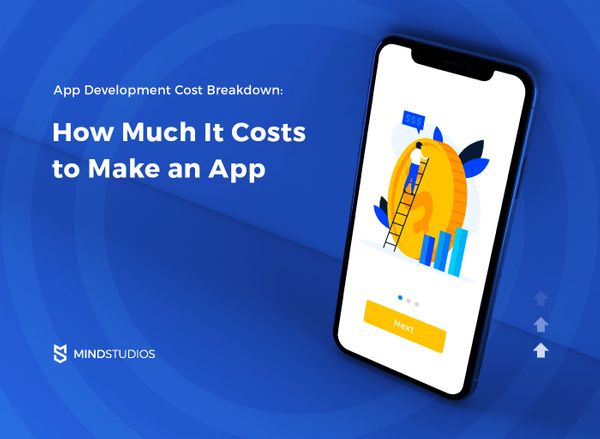
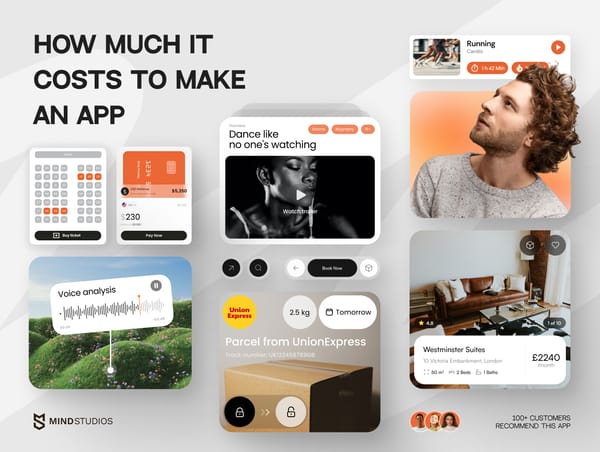
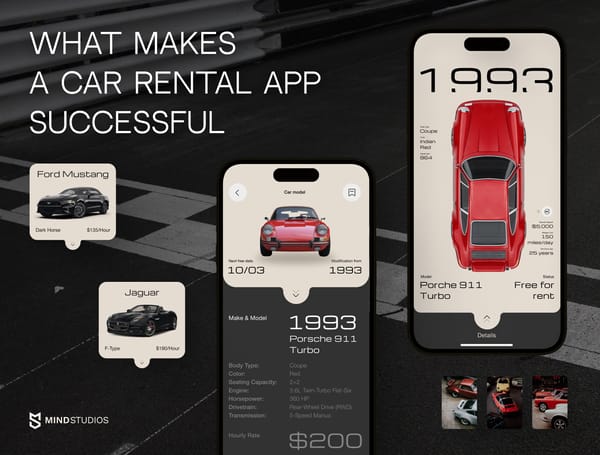
![How to Create an On-Demand Medicine Delivery App [Expert Guide]](https://themindstudios.com/blog/content/images/size/w600/2025/03/IMG-1-Cover-6.jpg)
